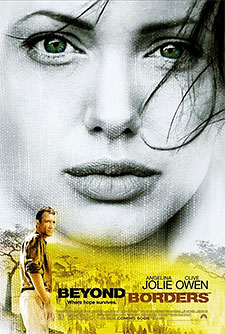
Baseball's Active Leaders, 2023
What Trump Said When About COVID
Recent Reviews
Everything Everywhere All at Once (2022)
Black Panther: Wakanda Forever (2022)
Doctor Strange in the Multiverse of Madness (2022)
Spider-Man: No Way Home (2021)
The Cagneys
A Midsummer Night's Dream (1935)
Something to Sing About (1937)
Angels with Dirty Faces (1938)
A Lion Is In the Streets (1953)
Man of a Thousand Faces (1957)
Never Steal Anything Small (1959)
Shake Hands With the Devil (1959)
Beyond Borders (2003)
Hollywood romances are generally divided into three parts: Boy meets girl, boy loses girl, boy gets girl. In “Beyond Borders,” the tri-part structure is slightly different: Ethiopia, Cambodia, Chechnya. Apparently no part of the world is so devastated that Hollywood can’t place a romance in its foreground.
It’s 1984 and, at a black-tie fund-raiser for world relief, Dr. Nick Callahan (Clive Owen of “Croupier”), dressed in grungy clothes and dragging along an emaciated African boy, crashes the joint to chastise the organization for cutting off his funding in Ethiopia, allowing thousands to die. The crowd’s reaction to this interloper is mostly haughty bemusement—someone even tosses a banana at the boy (who knew world-relief fund-raisers could be so cruel?)—but two people are moved: Sarah Jordan (Angelina Jolie), a recently married American socialite, whose eyes widen and sadden in an approximation of sympathy; and Jan Steiger (Yorick van Wageningen), a nefarious sort with possible connections to the CIA, whose eyes narrow with intrigue.
| Written by | Caspian Tredwell-Owen |
| Directed by | Martin Campbell |
| Starring | Angelilna Jolie Clive Owen Linus Roache Noah Emmerich |
Sarah is so moved, in fact, that she empties her bank account and travels with relief supplies to Ethiopia, where she learns that giving relief is often a Faustian bargain. She attempts to save a mother and child (the effects of starvation in the film were created by computer graphics), but the mother dies and the child may soon follow.
Dr. Callahan, meanwhile, treats her brusquely as a know-nothing do-gooder—which, of course, she is—but she’s feisty and argues back. Then one evening, he hears her playing Schumann on an abandoned piano and falls in love. Since director Martin Campbell (“The Mask of Zorro”) makes this Ethiopian village look like Tatooine, the desert planet in “Star Wars,” the sudden appearance of a tuned piano seems suspect at best.
Cut to: Five years later. Sarah now works for UNHCR (United Nations High Commissioner for Refugees), her husband is unemployed and philandering, and Dr. Callahan is saving lives in Cambodia — treading a thin line between Cambodian communists and the Khmer Rouge. When she accompanies relief supplies there, they rekindle their flirtation. Unknown to her, however, he’s smuggling weapons for Steiger in order to keep his operation going.
The third and final part of the film takes place in Chechnya, six years later.
“Beyond Borders” is the kind of movie you feel like a jerk dismissing, but here I go. There are intriguing performances (Owen, in particular) and indelible images (a crying baby holding a hand grenade), but the globe-trotting and time-jumping undercut the drama while the physical suffering in the background makes us care less about the romantic suffering in the foreground.
Jolie also acts a little too stunned in the first half of the movie to truly be interesting. A shame. Most of us are, at best, sympathetic observers and occasional donors to world-relief organizations. Jolie, like her character in “Beyond Borders,” actually got involved, adopting a Cambodian son and becoming the U.N.’s goodwill ambassador in 2001, a title she recently extended for two more years.
It’s an inspiring story. I just wish a better movie accompanied it.
—Origianlly appeared in The Seattle Times on October 24, 2003
© 2003 Erik Lundegaard







